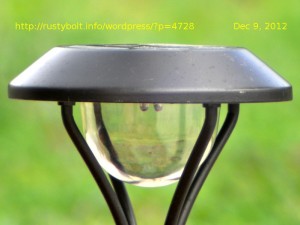 I got to thinking about solar powered garden lights, and it suddenly dawned on me. I have never seen one as simple as the common as dog doo-doo flashlights that use three AA cells.
I got to thinking about solar powered garden lights, and it suddenly dawned on me. I have never seen one as simple as the common as dog doo-doo flashlights that use three AA cells.
I’ll have to start with what I have observed in the limited number of garden lights that I’ve opened up and looked at the circuitry. All of them that I can remember have been using a Joule Thief or similar V boost circuit to boost the voltage of a single rechargeable cell. Yet when I look at the impulse items at the checkout counter, I almost always see cheap flashlights that use three AAA cells. They almost never use a single cell with a boost circuit, presumably because they are trying to make them at the lowest possible cost (they don’t have to include batteries).
Why didn’t the garden light designers use three rechargeable AAA cells instead of a single cell? Just think about it. With three AAA cells, the flashlight – and garden light too – would not need a V boost circuit. Eliminating that would save some, however there would still need to be a resistor to limit the LED current and a diode to prevent the batteries from discharging back through the solar cells.
It became apparent to me that there must be something else that was determining this, and then I concluded that the determining factor must be cost. The cost of three rechargeable cells, which the maker must supply, are more than the cost of the V boost circuit. And also there must be more solar cells to charge the batteries at 4.5 volts than at less than 2 volts for a single rechargeable battery.
Another thing that also occurred to me.
If I built my own solar garden light, I could use three rechargeable cells, and eliminate the V boost circuit, and get better performance, too. Since the Joule Thief or other V boost circuit eats up almost half of the power put into it, eliminating it would increase the efficiency of the light. I could then get more light, either by putting more current through the single LED, or putting more LEDs in the light. The solar cell would have to supply 4.5 volts, but that would be easy to do since most solar garden lights are so cheap I could scrounge two cells and put them into my solar light. Or I could keep the two lights and connect them so that their solar cells are in series, and thus able to charge more cells.
Back to thinking up more brilliant ideas…